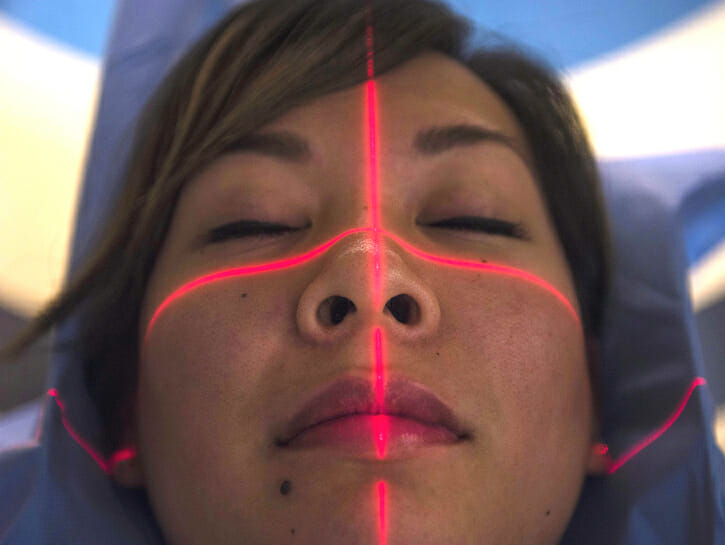Your Faceprint Tomorrow
The selling of facial recognition technology—and the staggering consequences I think I scan. / U.S. Department of Defense
I think I scan. / U.S. Department of Defense o
l
u
m
n
s
For years, facial recognition technology has been one of the great bogeymen for civil liberties advocates. The ability to be recognized and tracked across public spaces represents an epochal shift in the nature of privacy, something akin to being fingerprinted everywhere one goes. Like fingerprinting, facial recognition is a biometric, meaning that we can never modify what it measures; barring a horrific event (one it’s better not to contemplate), your faceprint will remain unchanged. And as with a fingerprint, your faceprint is a singular piece of data, a unique user name and password combination that follows you through the world. That’s a problem if, say, a biometric database gets hacked; the Indian government’s biometric database, which contains information like retina scans on 1.19 billion people, has been hacked repeatedly, with ID information selling on WhatsApp for $5 to $10. You can change a hacked password, but not a face.
In China, public toilets use facial recognition to ration toilet paper.
Long considered the province of security agencies—the FBI maintains an enormous facial recognition database comprising information on millions of Americans—this ominous technology has crept into the private sector, finding a keen reception from social media platforms, which are, like their government counterparts, invested in tracking their customers. Several years ago, Facebook announced that its own facial recognition engine could recognize faces with a level of accuracy rivaling that of human beings. But such declarations are mere mile-markers on the way to bigger things, namely the commercialization and widespread adoption of this technology of control. Based on the events of the last few months, it seems we’re approaching just that.
As Slaterecently noted, the use of facial recognition technology has already spread to the more mundane corners of the commercial sphere. KFC has employed a facial-recognition-based recommendation program in China, as has a burger joint in California. Walmart has promised to use it to analyze customers’ emotional responses, while the upscale retailer Saks Fifth Avenue has dabbled in using the technology to identify known shoplifters and VIP customers. At LAX, airlines are testing facial recognition as a replacement for boarding passes. In China, public toilets use the tech to ration toilet paper.
In the last couple of weeks, untold numbers of social media users have given their likenesses away to Google’s Arts & Culture app, which has a selfie feature that compares your face to those found in famous works of art. That most users likely upload their selfies without a second thought only shows how we’ve been trained not to value our own privacy, or to have a sense of ownership over our data. Beyond the impositions of the FBI or TSA, it seems that this is how facial recognition will move through society: by way of a trained passivity and, at times, the promise of entertainment and convenience.
That brings us back to Facebook, which in December introduced “optional tools to help people better manage their identity on Facebook using face recognition.” Once activated, Facebook’s facial recognition tool alerts people when they appear in others’ photos, including in someone else’s profile photo (which might indicate they’re being impersonated on the social platform). All of this may be a welcome kind of anti-fraud mechanism, but Facebook, true to form, aims higher in its aspirations. “Since 2010, face recognition technology has helped bring people closer together on Facebook,” the post adds triumphantly—as if facial recognition, rather than representing a sinister affront to personal privacy, is just another mechanism for encouraging closer relationships with loved ones.
Facebook’s announcement ends with uncharacteristic curtness: “We are introducing these new features in most places, except in Canada and the EU where we don’t currently offer face recognition technology.” What the statement doesn’t say: both of these governing bodies have passed regulations that limit what Facebook can do with your faceprint. Similarly, the Google selfie function isn’t available in Texas and Illinois, two states with biometrics regulations on the books.
Opposing facial recognition wholesale may seem like an untenable policy, but it’s time to ask who benefits.
Rounding out the ruling troika is Apple, the pacesetter in technological chic. Its Face ID feature, rolled out recently on the iPhone X, has been marketed as the ultimate marriage of security and style. “Introducing the most unforgettable magical password ever created,” the commercial crows: “Your face.” Over a dance-y garage rock number, we see a young woman cycle through a stream of creatively designed coiffures. No matter what she’s wearing, she can still unlock her phone with a look—“any look,” we’re told, cementing the double entendre. What might once have been considered a passive, even invasive, experience is now rendered interactive, fun, an act of performative whimsy.
The Apple commercial is revealing in all the typically unintended ways. It depicts a world in which one’s face is one’s password, yes, but also a permanent identifier, an invitation to be scanned and assessed, and a means of rather facile self-expression. It pays no attention to the fact that the menace of facial recognition lies in the possibilities it forecloses: to be unrecognized, unscannable, unknown as one passes through public life. (Not coincidentally, those possibilities have been similarly infringed upon by the pervasive spread of surveillance-enabling mobile phones and CCTV cameras.) Opposing facial recognition wholesale may seem like an untenable policy. But as with every newly introduced surveillance technology, it’s worth tracking the authoritarian impulses that animate it and asking who benefits: us, or whoever—or whatever—sits behind the controls?